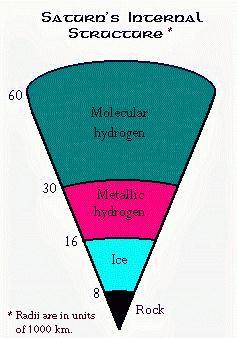

 |
Physical properties of Saturn: (Morrison, 275)
- Distance: 9.5 AU
- Period: 29.5 yr
- Diameter: 120,540 km
- Mass: 95 times that of Earth
(about 5.7e26 kg)- Density: 0.7 g/cm³
- Rotation: 10.7 hr
Saturn is the sixth planet from our sun and the second largest in our solar system.
The atmosphere is made up of mostly hydrogen along with hydrogen-based gases, such as ammonia and methane, and hydrocarbons, such as acetylene and ethane (Morrison, 274).
The internal structure of Saturn is mostly hydrogen and helium with "ice" and "rock" at the core. The "ice" is primarily made up of carbon, nitrogen and oxygen combined with hydrogen. The "rock" is primarily made up of iron, silicon, and oxygen (Morrison, 276).
Saturn's ring structure is made up of 7 major rings with 5 gaps/divisions.
| Feature | Radial Width (km) | Distance from Saturn Center (Rs) | Discoverer |
| D Ring inner edge | ---- | 1.11 | Voyager |
| C Ring inner edge | ---- | 1.2348 | Bond |
| Maxwell Gap | 253 | 1.4500 (center) | ---- |
| B Ring inner edge | ---- | (1.5244 - 1.5259) | Galileo |
| B Ring outer edge | ---- | 1.9477 | ---- |
| Huygens Gap | 430 | 1.9513 (center) | Voyager |
| Cassini Division | 4540 | 1.9854 (center) | Cassini |
| A Ring inner edge | ---- | (2.0230 - 2.0280) | ---- |
| Encke Gap | 328 | 2.2141 (center) | Encke |
| Keeler Gap | 31 | 2.2628 (center) | Voyager |
| A Ring outer edge | ---- | 2.2670 | ---- |
| F Ring center | 50 | 2.3267 | Pioneer |
| G Ring center | ---- | 2.8 | Pioneer |
| E Ring inner edge | ---- | 3 | Feibelman |
| E Ring outer edge | ---- | 8 | ---- |
There are 18 "named" satellites orbiting around Saturn. There have been at least 12 others reported but only given "provisional designations". Among the 18 "named" moons, Titan it the largest with a radius of 2575 km and Pan is the smallest with a radius of 10 km (Arnett).
 Main
Main
 References
References